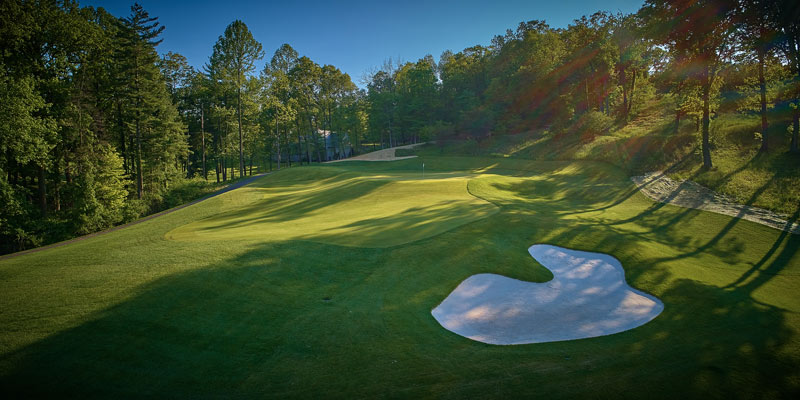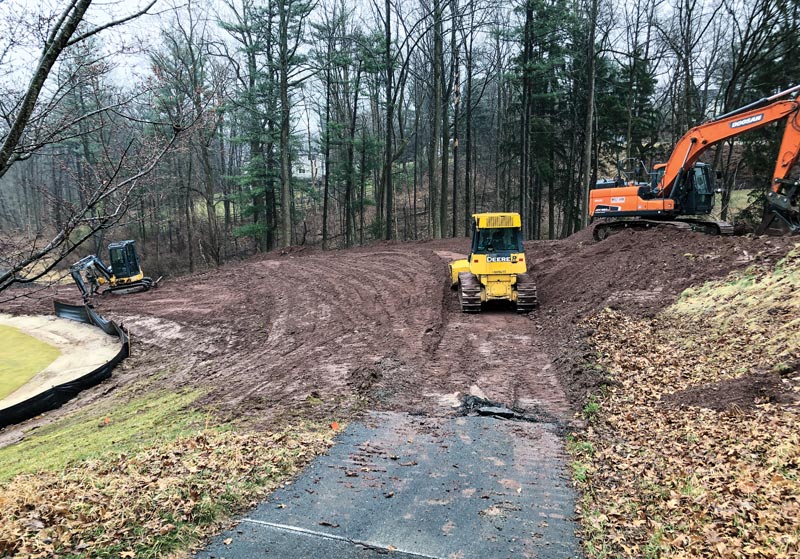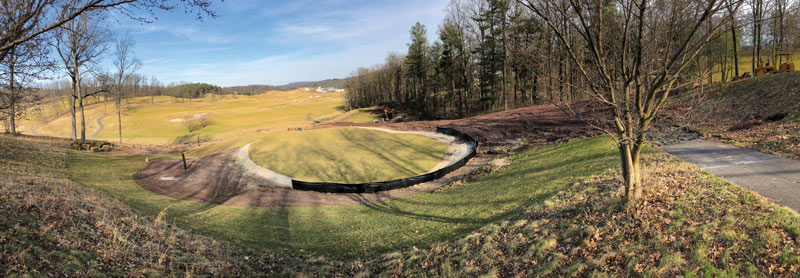
The redesigned and renovated par-4 17th hole at LedgeRock Golf Club in Mohnton, Pa., opened to rave reviews from members in May. Photo courtesy of LedgeRock Golf Club
LedgeRock Golf Club accommodated more golfers on May 23, 2020, than on any non-outing day in the club’s 14-year history.
Yes, it was a beautiful, sunny Saturday in Mohnton, Pa., only three weeks after COVID-19 restrictions had been lifted. But there was another lure at play: May 23 was the day members at this private club got their first crack at their renovated 17th hole, a par 4 that for 14 years had proved the bane of many a scorecard.
The reaction?
“Well, the immediate feedback — mostly texts — was very good,” reports Alan FitzGerald, GCSAA Class A superintendent at LedgeRock. “The president of the club made par there that first day, so he was very approving. The long-term, overall reception has been great, actually. We have a second phase of the same project coming up, so I hope the members remember how well they liked phase one.”
Very little about the recent renovation at LedgeRock could be described as typical. Indeed, very little about this club is typical. Most renovation work in this part of the country is undertaken in fall. That allows construction crews the opportunity to work until the snow flies, and also allows new turf to incubate all winter and mature in early spring. At LedgeRock, ground was broken on the first phase of this two-part project in mid-February 2020, with plans to reopen the hole by mid-May.
In another twist, the project was largely undertaken by FitzGerald himself, using in-house crews under the direction of architect Rees Jones, who authored the original design at LedgeRock GC back in 2006.
What’s more, phase one was funded in a different sort of way — not via traditional member assessments, but rather by voluntary membership donations. In fact, that’s one reason the work was authorized and ground was broken with such speed.


Two perspectives of the 17th hole at LedgeRock Golf Club prior to this year’s renovation. A wide cross bunker in front of the green and thick rough behind it combined to make it the club’s most difficult hole. Photos courtesy of Alan FitzGerald
“LedgeRock is a different sort of place,” says FitzGerald, a 23-year GCSAA member and native of Ireland, who is the only superintendent the club has ever had. “One of the restrictions the state imposed starting May 1 was 15-minute tee times. Well, we’ve never really had tee times here. People just show up and do their own thing. But we were so busy in May, I’m glad we had them. It would have been chaos otherwise.
“Basically, people are really invested in this place, and I suppose that informs the way things get done around here. And they aren’t much for lengthy meetings and drawn-out procedures. I was actually in Orlando for the Golf Industry Show in late January, and I was explaining to Rees Jones what we had in mind for 17. He said, ‘Well, I’ll be there as soon as you guys are ready to go,’ thinking that would be months or at least weeks down the road.
“Well, I got home a couple days later, and our general manager, Gerry Heller, had secured the funding authorization from our members, so I called Rees that first week in February and asked him, ‘When can you be here?’”
Why wait?
FitzGerald is not a construction neophyte; he was involved in the original build at LedgeRock. The Penn State graduate also gathered considerable renovation experience during assistant superintendent stints at Pine Valley Golf Club in Clementon, N.J., and the Mount Juliet Resort in his native Ireland. In 2019, he and his crews undertook another Jones-led renovation, this one on the par-3 10th hole at LedgeRock.
Indeed, FitzGerald’s in-house construction capability affords him extraordinary flexibility to undertake a renovation in February, for example, and to have golfers playing the new hole by late May.
Watch: GCM Editor-in-Chief Scott Hollister and superintendent Alan FitzGerald delve into more details of the renovation work on LedgeRock’s 17th hole, chat about FitzGerald’s journey from Ireland to the U.S., and more in this installment of GCSAA TV’s “Live from the Course”:
“We had thought about trying to do 17 when we renovated No. 10 last spring, but for several reasons, it didn’t make sense,” explains Heller. “One reason we pulled the trigger this winter was Alan himself. The work his team did at the 10th hole was so well received, and under budget, I might add. Once we had gone over the project at 17 in real detail — to confirm all the numbers were solid — the members didn’t see any reason to wait.”
The weather cooperated, even if the prevailing national health situation did not.
“We were well underway by the time the COVID-19 situation hit home here in the U.S.,” Heller says. “But golf is one of the few sports where social distancing can be effectively maintained. We’ve seen that here and elsewhere. The same can be said of course renovation work, frankly. After consulting with Alan, his crews, Rees Jones and his lieutenant, Bryce Swanson, we continued the work full speed ahead. There are extra precautions to be taken. But outside, on your own, is about the safest place to be these days.”
Softening LedgeRock’s rough edges
LedgeRock GC opened in 2006. It lies 15 minutes southwest of Reading, on 212 acres of terrain marked by striking elevation changes and a half-dozen roaring brooks that run through the property. In today’s uncertain market — an average of 150 courses have closed each year since 2008, according to the National Golf Foundation — LedgeRock has thrived by doubling down on golf itself. There are no tennis courts or swimming pools here. Just a nationally ranked golf course and one of the region’s most expansive practice facilities, which doubles as a sort of social hub — another clubhouse just down the hill from the actual clubhouse. Farther down the hill sits Kohl Lodge, where national and regional members can stay the night.
The par-4 17th at LedgeRock had always been demanding. Its sharply uphill approach — across a water hazard, over a cross bunker to a green nestled into a steep hillside — is one reason it’s the No. 1 handicap hole, far and away the club’s most difficult.
“In many ways it has always played as a half-par hole, a tough par 4 for long hitters and a par 5 for shorter hitters,” Jones says. “And the cross bunker was an issue.”
Phase one of the renovation replaced the cross bunker with a single small bunker on the right, creating a generous lay-up area short and left of the putting surface. But Jones also reimagined the green complex itself. Where it had been flanked left by a greenside bunker, with bluegrass rough behind and to the right of the green, Jones artfully designed greenside chipping areas right and left, allowing players a variety of recovery shots.

Rees Jones, LedgeRock’s original designer, oversaw the renovation of the club’s 17th hole, which included replacing the wide cross bunker in front of the green with a single small bunker on the right side and reimagining of the green complex itself. Image courtesy of LedgeRock Golf Club
Beyond the green, a wide fairway-cut swale has been created to catch approach shots that in the past would have skittered over the green into thick rough.
“On a hole this long and this uphill, players naturally take a bit of extra club to be sure they ‘get there.’ But that downhill chip from the rough over the green at 17 was very difficult,” FitzGerald says. “Now they can putt from back there. They can putt from everywhere around the green, including short left. Better players chip, but that’s a tough shot off a tight bentgrass surface. The green surface has not been touched, but everything around it has been radically expanded, regraded and softened to give players the chance to recover if they happen to miss the target.”
FitzGerald and his crew handled all the bulk earthwork and shaping. Because COVID-19 resulted in some short staffing at the club, in April, a nearby contractor, the George E. Ley Co., was retained to assist with irrigation, fine grading and sodding. The company also equipped the new bunker with Blinder bunker liner.
“We made the decision to sod these renovated areas with bentgrass, to move things along schedule-wise,” FitzGerald says. “The plan was to get it open by May 1. I thought mid-May was more realistic; it ended up being May 23. Even if there was no pandemic, we’d have only lost maybe a month of play on the hole.”
Refresh, round two
Phase two of work on No. 17 is scheduled for October, on a more traditional renovation schedule. The design calls for significant widening and regrading of the landing area, which is flanked on the left by one of LedgeRock’s many babbling brooks. By widening the landing area, more golfers will be inclined to hit a driver off the tee, which should shorten the length of the uphill approach shot.
“The grading on 17 fairway will accomplish two things,” FitzGerald explains. “We’re making the fairway more concave, so off-center drives will kick into more advantageous positions. But we’ll also be building up the left side of the fairway to add more landing area. When it’s done, that landing area will be a third larger.”
Editor’s note: Read about LedgeRock Golf Club’s partnership with a local school district, which gives budding woodworkers the opportunity to apply their skills in the real world, and gives superintendent Alan FitzGerald a hand with environmental stewardship.
Truth be told, the timing of the second phase remains somewhat up in the air, FitzGerald says. The club has been emboldened by the winter/spring schedule that worked so well during phase one. “It’s somewhat dependent on the next round of member donations,” he says. “With COVID, we just don’t know what pushing too hard on that sort of thing will look like.”


Work on the 17th hole at LedgeRock Golf Club began in February 2020, and the refreshed hole (bottom photo) reopened for play on May 23. Photos courtesy of Alan FitzGerald
As such, FitzGerald hedged his bets (and the club’s) by including in phase one a new forward tee and cart path extension. The path now extends the full length of No. 17.
“That’s always been one of our wettest fairways, so it made sense on that level,” FitzGerald says. “And now we don’t have to shut the hole down in order to execute phase two. We can play No. 17 as a par 3 during construction, this fall or next spring, as we choose. The extended cart path allows golfers to completely bypass the hole, basically. Golfers can shoot up the path, and any sort of construction won’t be in their way — and they won’t be in our way.”
Bucking the trend
The sort of renovation/reinvestment taking place at LedgeRock is not on the radar at most private clubs in 2020. Indeed, larger industry issues in eastern Pennsylvania far outweigh any pandemic. Berks County alone — where LedgeRock is located — has seen a dozen golf properties shuttered over the past decade. Reading Country Club, just north of LedgeRock, is operational but not as a private club. In the nearby Harrisburg area, Blue Ridge Country Club, Wren Dale Golf Club and Felicita Golf Club have all been closed since 2012.
“We do feel as if we have reimagined the traditional private club model here at LedgeRock,” Heller says. “Our national and regional membership programs are part of that evolution. Your golf course has to be truly top-drawer to make that work, of course. But again, I have to credit our members for the attitude and atmosphere that prevails here. They’ve allowed us to streamline operations and decision-making. I’ve been in this business for 35 years. I’ve never seen a project like No. 17 approved in this way — with voluntary donations versus a club-wide assessment — or this quickly.
“But you know what? Guess who benefits? The members do. They’re playing that new hole right now, instead of waiting till 2021.”
Hal Phillips is the managing director of golf and resorts for Mandarin Media, a public relations firm with offices in Portland, Maine; Park City, Utah; and Ho Chi Minh City, Vietnam. He is the former editor of Golf Course News.